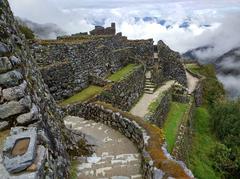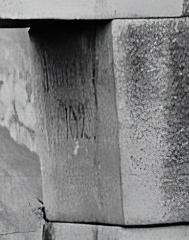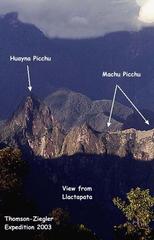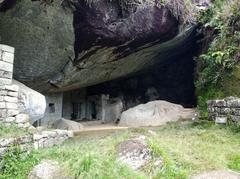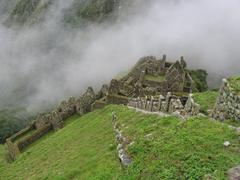
Sayacmarca Visiting Hours, Tickets, and Historical Significance: The Ultimate Guide
Date: 15/06/2025
Introduction to Sayacmarca
Perched at approximately 3,600 meters (11,800 feet) above sea level in the Andes, Sayacmarca—meaning “Inaccessible Town” in Quechua—is one of the most awe-inspiring sites along the Classic Inca Trail. Unlike Machu Picchu, Sayacmarca remains relatively untouched, providing a rare and authentic window into the architectural sophistication, strategic planning, and spiritual life of the Inca Empire. Its dramatic location, complex stonework, and innovative water management systems highlight the Incas’ mastery of high-altitude settlement building, while its role as a checkpoint and ceremonial center underscores its importance within the vast Inca road network (thebrainchamber.com; incatrailmachupicchu.org; Tierras Vivas).
This comprehensive guide details Sayacmarca’s history, architecture, visiting hours, ticketing, accessibility, conservation, and practical travel advice. Whether you’re planning to trek the Inca Trail or seeking insight into Andean heritage, this resource equips you for a meaningful and responsible visit.
Historical Background and Cultural Significance
Origins and Rediscovery
Sayacmarca’s origins can be traced to the expansion of the Inca Empire in the 15th century, particularly under Emperor Pachacuti. Archaeological evidence suggests the site may have pre-Inca roots, possibly established by the Colla people before the Incas integrated and expanded it (activeadventures.com). Sayacmarca was rediscovered in 1915 by Hiram Bingham and later renamed by Paúl Fejos in 1941 (incatrailmachupicchu.org).
Architectural Features
Sayacmarca’s construction exemplifies classic Inca dry-stone masonry, with walls built without mortar for seismic resistance. Key structures include:
- Double-jamb gateway: Signifying ceremonial or administrative importance.
- Semicircular religious temple: Possibly aligned with solar events and mountain worship.
- Residential quarters and terraces: Supporting a self-sufficient population of around 200.
- Plazas and ceremonial spaces: Indicating ritual and social functions.
The site is accessible via a narrow stone staircase with more than 98 steps, designed for defense and control (thebrainchamber.com; incatrailmachupicchu.org).
Strategic and Spiritual Role
Sayacmarca’s ridge-top location enabled surveillance over the Inca Trail, serving as a checkpoint for travelers, messengers, and military personnel. The site’s ceremonial spaces and water features highlight its spiritual significance, with rituals likely performed to honor deities and natural forces (thebrainchamber.com).
Visitor Information
Visiting Hours and Tickets
- Hours: Sayacmarca is open to trekkers during daylight, typically from 6:00 AM to 5:00 PM, in line with Inca Trail trekking schedules.
- Tickets: Entry is included in the Classic Inca Trail permit, which covers all archaeological sites along the route. Independent access without a permit or guide is not permitted.
- Permit Booking: Permits are capped at 500 daily (including guides and staff) and must be purchased 6–7 months in advance through authorized agencies (machupicchu.org; Peru Hike).
How to Get There
Sayacmarca is located approximately 20 kilometers from the Inca Trail’s start near Cusco and is reached on day 3 of the classic 4-day trek. There are no roads; it is only accessible by foot via the official Inca Trail route.
Accessibility
The site’s steep stairs, narrow passageways, and rugged terrain require good physical fitness and pre-trek acclimatization. It is not suitable for those with mobility challenges.
Guided Tours
All trekkers must be accompanied by certified guides, who provide context, ensure safety, and help protect the site. Most group sizes range from 8–16, with smaller groups available.
Sayacmarca in Detail
Architectural Highlights
- Terraces and Drainage: Ingenious terraces maximize arable land and control erosion (Exploor Trip).
- Central Plaza: Surrounded by ceremonial and residential structures, reflecting sophisticated urban planning.
- Water Management: Advanced irrigation channels, fountains, and ritual baths ensure reliable water supply and site preservation (Exploor Trip).
- Defensive Features: Robust walls and the steep mountainside provide natural fortification.
Integration with the Inca Trail
Sayacmarca served as a key node in the Inca road system, controlling movement and facilitating communication between major settlements (thebrainchamber.com; incatrailmachupicchu.org).
Practical Travel Tips
When to Visit
- Best Season: May to September (dry season) offers the most stable weather.
- Trail Closure: The Inca Trail closes every February for repairs and restoration.
What to Bring
- Sturdy hiking boots
- Layered, moisture-wicking clothing
- Waterproof jacket/pants
- Hat, gloves, sunscreen, sunglasses
- Water and snacks
- Trekking poles
- Camera and extra batteries
- Passport (required at checkpoints)
- First aid kit and altitude medication
Responsible Tourism
- Leave No Trace: Carry out all waste.
- Stay on Trails: Prevent erosion and protect fragile areas.
- Respect the Site: Do not climb on or touch ruins; photography is permitted, but drones require special permits.
- Support Local Communities: Use certified operators and consider community-based tourism initiatives (machupicchutours.tours).
Conservation and Sustainability
Sayacmarca’s remote location helps preserve its authenticity. However, increasing visitor numbers have prompted robust conservation measures:
- Daily Permit Limits: Enforced to control foot traffic.
- Annual Trail Closures: February is reserved for maintenance and ecosystem recovery.
- Waste Management: Strict pack-in, pack-out policies and eco-friendly campsites (kadatravel.com).
- Ongoing Restoration: Utilization of traditional techniques to stabilize structures.
Nearby Attractions
- Phuyupatamarca: Known as “The Town Above the Clouds,” another major Inca Trail site.
- Wiñay Wayna: Spectacular terraces and water features.
- Runkurakay: Semi-circular Inca ruins passed before Sayacmarca.
- Machu Picchu: The iconic finale of the Classic Inca Trail.
Frequently Asked Questions (FAQ)
Q: What are Sayacmarca’s visiting hours?
A: Access is from around 6:00 AM to 5:00 PM, aligned with Inca Trail trekking hours.
Q: Do I need a separate ticket for Sayacmarca?
A: No, access is included in the Classic Inca Trail permit.
Q: Can I visit Sayacmarca independently?
A: No, all visits must be part of a guided Inca Trail trek.
Q: Is Sayacmarca suitable for children or elderly visitors?
A: The trail is challenging and best suited to fit, acclimatized adults.
Q: Are drones allowed?
A: Drones generally require special permits and are usually not permitted.
Conservation Challenges and Solutions
Environmental Pressures
- Erosion: Heavy trekking impacts ancient stonework and paths.
- Waste: Increased litter and human waste require diligent management.
- Biodiversity: Noise and off-trail movement threaten wildlife.
Management Strategies
- Permit and Visitor Caps: 500 daily on the Inca Trail, including staff.
- Restoration and Maintenance: Annual closures and ongoing stabilization.
- Education: Guides promote conservation awareness.
- Community Involvement: Local residents participate in guide services, maintenance, and tourism management (machupicchutours.tours).
Responsible Travel Checklist
- Book early with certified operators.
- Prepare physically and acclimatize in Cusco.
- Respect all rules and site boundaries.
- Support local businesses.
Visuals and Interactive Recommendations
Include high-quality images with descriptive alt tags such as:
- alt=“Sayacmarca archaeological site terraces”
- alt=“Stone staircase at Sayacmarca Inca Trail”
- alt=“Panoramic Andes view from Sayacmarca’s semi-circular ceremonial site”
Consider embedding an interactive map of the Inca Trail highlighting Sayacmarca’s location.
Conclusion
Sayacmarca stands as a testament to Inca ingenuity, blending strategic, administrative, and spiritual roles within a challenging landscape. By planning ahead, respecting conservation protocols, and engaging with local communities, visitors help safeguard this incredible site for generations to come. Sayacmarca is more than a stop along the Inca Trail—it’s a profound journey into the heart of Andean civilization.
Sources and Further Reading
- Sayacmarca: A Complete Visitor’s Guide (The Brain Chamber)
- Sayacmarca Archaeological Site (Inca Trail Machu Picchu Official)
- Sayacmarca: History and Visiting Information (Tierras Vivas)
- Sayacmarca Site Overview (Exploor Trip)
- Sayacmarca on the Inca Trail (Lorenzo Expeditions)
- Inca Trail Permits and Machu Picchu Tickets (Peru Hike)
- The Impact of Tourism on Machu Picchu Conservation (Kada Travel)
- Machu Picchu Official Site
- Sustainable Tourism Plans (Machu Picchu Tours)
